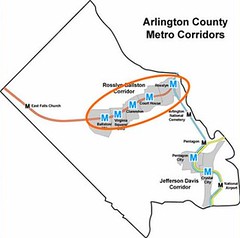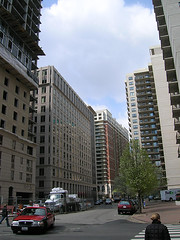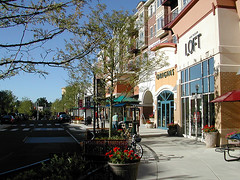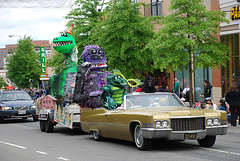Transit-oriented development in Arlington: stunning success and some lessons (part 2)

Posted June 24, 2008 at 1:23PM
Yesterday I wrote about how Arlington, Virginia’s redevelopment along one of the Washington, DC region’s Metro subway lines has created an amazing amount of new mixed-use development - all without expanding the region’s development footprint, while preserving the community’s single-family residential neighborhoods, and while strengthening the county’s tax base.
 If all Arlington had done was to provide new housing and office space in an existing community at smart densities, thus saving thousands of acres that might otherwise have been developed as sprawl on the region’s fringe, the planners would have earned our praise. But here’s the really good news: Arlington also greatly reduced automobile dependence, providing residents and workers with convenient transportation choices, putting shops and many other daily destinations within walking distance of homes and offices, and shortening distances for those who need or prefer to drive.
If all Arlington had done was to provide new housing and office space in an existing community at smart densities, thus saving thousands of acres that might otherwise have been developed as sprawl on the region’s fringe, the planners would have earned our praise. But here’s the really good news: Arlington also greatly reduced automobile dependence, providing residents and workers with convenient transportation choices, putting shops and many other daily destinations within walking distance of homes and offices, and shortening distances for those who need or prefer to drive.
It worked. Today, fewer than half of the residents in the Rosslyn-to-Ballston corridor drive to work. 39 percent use public transportation, and over 10 percent walk or bicycle (2.3 percent work at home). Perhaps most significant, the additional 17 million square feet of office space and 24,000 homes have added only minimal automobile traffic. Mariia Zimmerman of Reconnecting America reports that the daily traffic count on the corridor’s main street, Wilson Boulevard, was around 15,000 vehicles in 1980; in 2004, it was 15,795. (In 1980, before the redevelopment began, the county had been predicting that the count would soar to 36,900 vehicles per day!) The count on nearby Washington Boulevard actually decreased from 1980 to 2004, from 20,000 to 17,230.
Arlington’s lovely single-family neighborhoods remain lovely, and now residents can walk to more neighborhood conveniences and Metro, without suffering the traffic increases people sometimes fear from intensive development.
As Roger Lewis points out in The Washington Post,
"The corridor functions well. It offers pedestrian-friendly sidewalks, on- and off-street bicycle lanes, plazas and mini-parks. It takes less than 10 minutes to walk between any two adjacent Metro nodes on the corridor -- Rosslyn, Court House, Clarendon, Virginia Square and Ballston. People there can get along without cars.
"Appropriately high densities and multiple uses -- commercial, residential, civic, cultural and educational -- are concentrated at each node. Intense redevelopment and convenient transportation have made the corridor successful as a place to live, shop and play, as well as to work or commute to work."
Well said. Although the corridor's redevelopment is outstanding, I can’t say that it’s perfect. Roger also notes that the “urban design is not flawless,  and much of its architecture is less than exemplary.” I have to agree. Although I love Clarendon and find much to like near the Court House and Virginia Square stations, some of the new concrete-canyon development around the Ballston station feels uninspiring at best and oppressive at worst. Surely it confirms NIMBY fears of what transit-oriented development might bring elsewhere, which is too bad. I say to take Ballston as a valuable lesson to provide more architectural and building-height variety, along with more green space, in future development near transit, and look to Clarendon instead for the better model.
and much of its architecture is less than exemplary.” I have to agree. Although I love Clarendon and find much to like near the Court House and Virginia Square stations, some of the new concrete-canyon development around the Ballston station feels uninspiring at best and oppressive at worst. Surely it confirms NIMBY fears of what transit-oriented development might bring elsewhere, which is too bad. I say to take Ballston as a valuable lesson to provide more architectural and building-height variety, along with more green space, in future development near transit, and look to Clarendon instead for the better model.
High-rise glitches aside, this is an amazing success story. The amount of development in Arlington went way, way up compared to what was forecast in the 1970s, while automobile traffic on the arterial and residential roadways basically stayed the same. New homes, shops, and offices were provided close to public transportation and close to the region’s center.
Arlington could rest on its laurels but, instead, the planners are now looking to innovative, citizen-endorsed redevelopment of another section of the county that has suffered decline, the Columbia Pike corridor, and this time the development will be supported by streetcar service. (Watch this space for a future post on Columbia Pike.)
I believe the country has turned a corner and this, not sprawl, is our future. Arlington is setting a terrific example, and I'm lucky to be able to visit anytime I want, right across the river from DC.
Did you see the Washington Monument and US Capitol in the photograph that opened yesterday’s post? If not, look again. You can see the Jefferson Memorial, too.

